#the world’s greatest comic magazine
Text

Fantastic Four #15
#fantastic four#the thing#ben grimm#mr fantastic#reed richards#the human torch#johnny storm#the invisible woman#susan richards#giant brain#metamind#scary#uh oh#the world’s greatest comic magazine#alex ross#marvel comics#comics#2020s comics
38 notes
·
View notes
Text

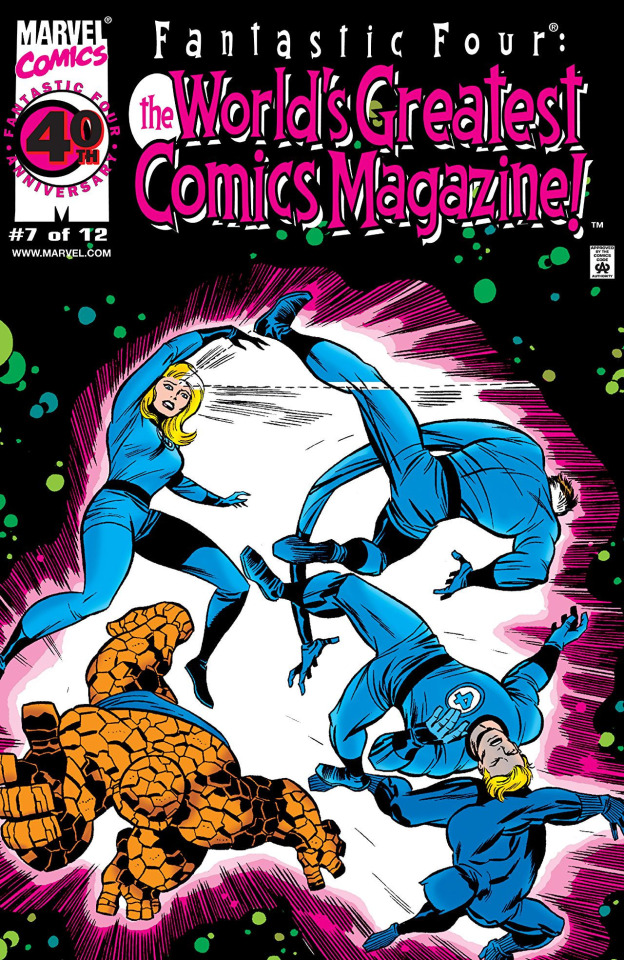
Fantastic Four: the World’s Greatest Comic Magazine, Vol. 1 # 07, by Bruce Timm and Keith Giffen.
#Fantastic Four: the World’s Greatest Comic Magazine#Fantastic Four#Black Panther#Bruce Timm#Keith Giffen#Master Class#Cover Process#Process#Marvel Comics#Marvel#Comics#Art#Illustration
64 notes
·
View notes
Photo

SIC SEMPER TYRANNIS
#fantastic four#doctor doom#cosmic cube#erik larsen#steve rude#2002#Fantastic Four: World's Greatest Comics Magazine
42 notes
·
View notes
Text
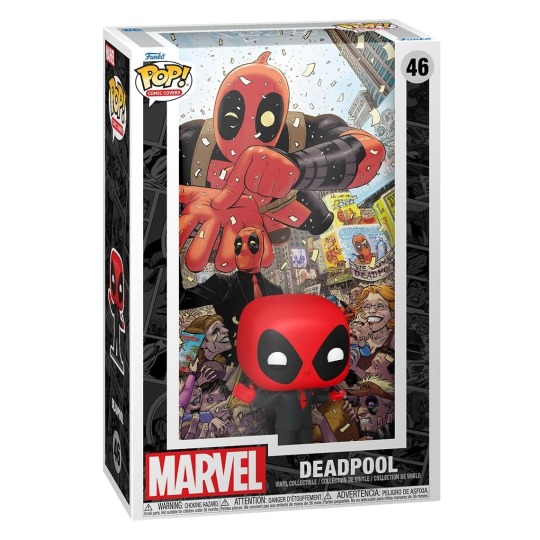


Funko Pop Comic Covers Marvel Deadpool in Black Suit - 46
Link para compra BR: *Possível importar pelo Link abaixo
Buy here: https://amzn.to/487BZ00
#Funko Pop#Action Figure#marvel#comics#deadpool#wade wilson#comic covers#black suit#Deadpool Worlds Greatest Comic Magazine
1 note
·
View note
Text
When he first came out in 1938, in terms of how his character was portrayed, Superman wasn’t just unique and captivating because of his amazing powers and charming personality. He was by many accounts of entertainment at that time…an exception to the norms
One of the many ways Action Comics #1 changed everything: The fictional concepts of ‘aliens among us’, ‘Being with Godly Powers’ and how they’re combined with the Pulp Hero which led to Superman.
The thing is
A lot of these stories of beings with godly powers beyond those of mortal men would often be portrayed as an antagonistic to outright villainous force meant to horrify their victims with the overarching mantra of Absolute Power Corrupts Absolutely. It’s a trend we seen play out a lot of times in our current media when beings who either gain or often times posses godlike powers are either villainous last obstacles for our hero, their greatest challenge or as like seen sometimes in shows including Star Trek, beings of thousand of years old who long detached themselves from the affairs of beings considered ‘lesser’ than them with little to no interference, meant to be observed. There’s certainly a probably chance of characters like these being the norm even for stories in pulp novels, magazines and other media back then in the 30s
More telling since they had popularity even lasting beyond Action Comics #1’s first printing, if that superpowered being has alien origins, they’re those that usually either don’t understand the concept of morality as we lowly humans do and utterly so alien and abomination in mere appearance, looking at them directly can drive some to madness a la HP Lovecraft whose works find routine publication from as early as 1908 and only ended in 1936 or in the case of say War of the Worlds who had a very notable radio adaptation in 1938 (which caused a bit of mass panic due to timing of people tuning in their radios before announcements and title introductions were made) they might understand that morality and they given to destroying our civilization anyways in conquest as an allegory for Imperialism at that time
In both of these types of stories, any being even those with a humanoid appearance are seen as others or outside forces that are threats to humanity and especially the average Joe and they were stories that came out prior to Action Comics #1. Prior also to that comic, sure they were some superheroes usually in either mythology like Hercules or pulp heroes a la the Phantom
Superman when he first came out was an exception to all of that
For a simple reason, he could’ve been on of those aliens who were detached from the reality around them by their age and wisdom, an invading ruthless conquerer like HG Wells’ Martians, a abomination who mere acts of simply existing in our realm invokes dread, despair and fear of what unknown entities he can be linked to that overpower us lowly humans a la The Colour Out of Space or even the faceless one Nylarathotep or even a man who when gaining his great power eventually descends into utter madness and villainy for their own selfish gains which ironically was what the duo of Jerry Siegel and Joe Shuster had in mind for their planning stages of this brand new creation they wanted to share.
Even for a heroic example, Clark could’ve simply been a simple man with a bright costume and a gimmick in an attempt to cash in the small notable trend the Phantom had set up into his adventures coming out a mere years before Action Comics
And yet Superman wasn’t any of that. He was simply a humanoid alien immigrant who was raised by a kindly couple and from an early age decides to use his newfound godlike powers and incredible abilities not to frighten, not to be detach, not to conquer….he just wants to help. He’s a Champion of the Oppressed, a living marvel dedicated to helping those in need.
All of those other examples of what people had for character prior to Action Comics #1 are what they are….
Superman Can. And he can do that, cause he was and still is the exception
#clark kent#golden age#jerry siegel#joe shuster#hp lovecraft#the phantom#war of the worlds#opinion#my posts#superman#action comics
62 notes
·
View notes
Text

That's one way to get a guy's attention.
Fantastic Four: World's Greatest Comics Magazine issue #8
#tony stark#iron man#avengers#reed richards#mr. fantastic#fantastic four#lab notes#marvel 616#earth 616#comics
140 notes
·
View notes
Text
Tezucomi magazine receives a 2 volume release in North America in 2024; will only include manga from European artists
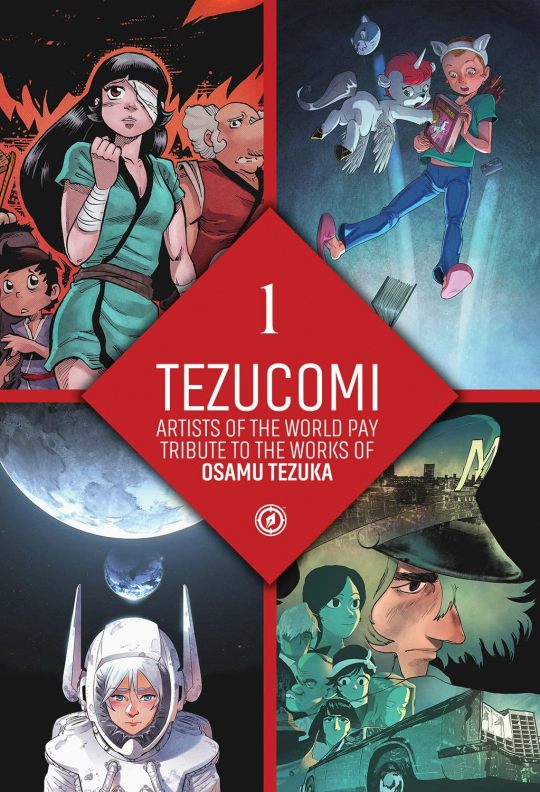

Sources: Amazon (Volume 1, Volume 2), Kickstarter
Tezucomi manga magazine will receive a 2 volume North American release through Magnetic Press; it will only include the European manga that were included in the original release from Japan.
Tezucomi Volume 1 is set to release on February 13, 2024, while Volume 2 will release on March 12, 2024.
These releases came about from a successful Kickstarter from Neurobellum Productions!
Tezucomi was an Osamu Tezuka anthology magazine containing manga drawn from comic/manga artists around the world. It began in 2018 and ran for 18 volumes.
A summary of both volumes as posted on Amazon's website:
Volume 1:
An anthology of short stories based on some of the many popular creations of legendary Japanese mangaka Osamu Tezuka, as illustrated by a collection of some of the greatest comic creators in Europe. This larger 300-page hardcover edition is presented in traditional manga reading order, right to left.
This first volume includes "The Mouse" by Sourya, based on AYAKO; "The Moon Rabbit" by Brice Cossu and Valerie Mangin, based on BUDDHA; "A Taste for Blood" by Philippe Cardona and Florence Torta, based on DORORO; "The Cursed" by Mathieu Bablet, based on METROPOLIS; "The Eyes of Pandora" by Victor Santos, based on MW; "Love at First Sight" by JD Moravn and ScieTronc, based on MIDNIGHT; "Doppelganger" by Belen Ortega and Victor Santos, based on BARBARA; "The Parchment of the Cat" by Kenny Ruiz, based on MY SONGOKU; and "Catalante" by Mig, based on UNICO.
Volume 2:
An anthology of short stories based on some of the many popular creations of legendary Japanese mangaka Osamu Tezuka, as illustrated by a collection of some of the greatest comic creators in Europe. This larger 300-page hardcover edition is presented in traditional manga reading order, right to left.
This second volume includes "Big X" by David Lafuente, based on BIG X; "The Creator and the Destroyer" by Philippe Cardona and Florence Torta, based on ASTRO BOY; "The Last Recital" by Bertrand Gatignol, based on BLACK JACK; "The 3 Richards" by Juan Diaz Canales, based on MESSAGE TO ADOLF; "The Guardian of Mount Moon" by Reno Lemaire, based on KIMBA THE WHITE LION; "Mina's Song" by Luis NCT, based on APOLLO'S SONG; "Heartless" by Joe Kelly and Ken Niimura, based on BLACK JACK; "Princess Knight" by Elsa Brants, based on PRINCESS KNIGHT; and "Team Phoenix" by Kenny Ruiz with Studio Kosen, based on several works of Osamu Tezuka.
22 notes
·
View notes
Text
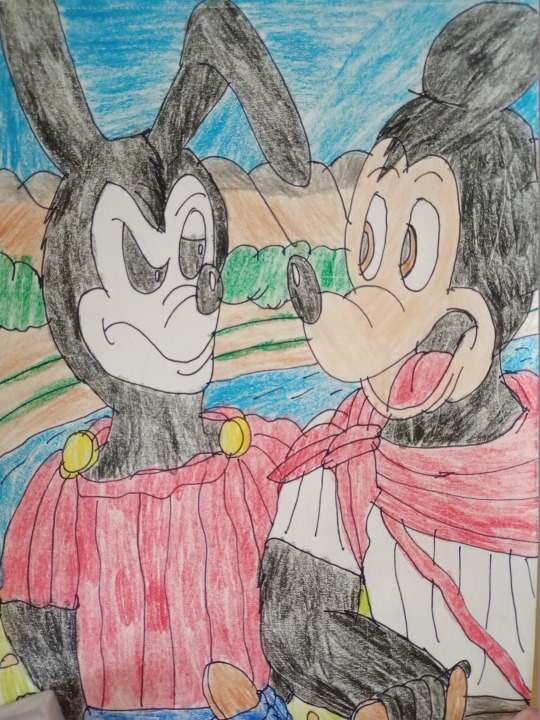

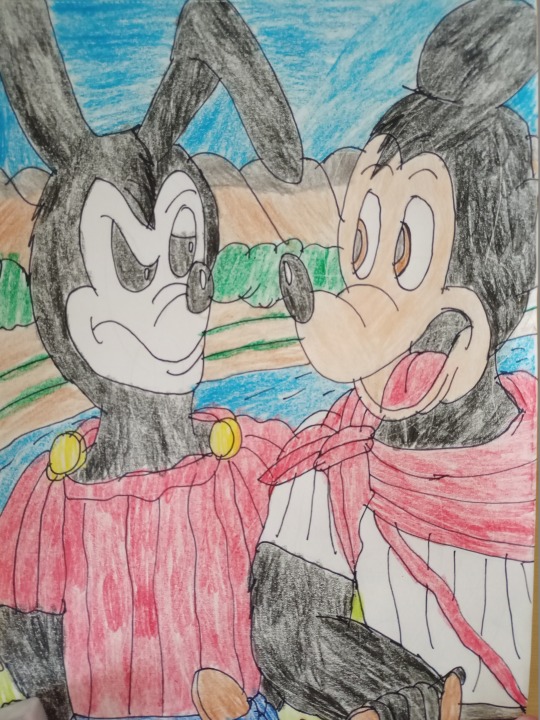

Mickey Mouse and Oswald the Lucky Rabbit as Romulus and Remus, as the founders of Rome - Toon History - History in Duckverse and Mouseverse - Happy Birthday to the Best City!
Yes, it's time to change my plans now with my new project called Toon Historia, also History in Duckverse and Mouseverse in which our famous cartoon and comic characters play famous historical figures and will play in important historical events . And first I drew Oswald the Lucky Rabbit and Mickey Mouse as the founders of Rome, as Romulus and Remus. Romulus and Remus, according to Roman mythology and Roman tradition, were the sons of Rhea Sylvia and the god Mars and grandsons of King Numitor. Numitor's brother Amulius overthrew his brother and ordered the execution of his children, including the sons of Sylvia who were thrown into the Tiber River. However, according to legend, a she-wolf found them and raised them until the shepherd Faustulus came along and adopted them. Afterwards they grew up and when they heard the truth, they went to overthrow Amulius and succeeded and restored their grandfather Numitor to be king of the city of Alba. Afterwards, Romulus and Remus went to seven hills in the valley of the Tiber River and there on April 21, 753 BC they founded the eternal city, which will be called Rome. Yes, there was a conflict between the two in which Romulus killed his brother (a tragic event) and thus took the title of the first king of Rome.
Oswald and Mickey who were created by Ub Iwerks and Walt Disney in 1927 and 1928 also became the first Disney icons, however the conflict between Iwerks and Disney resulted in Oswald being part of Universal, until in 2006 Disney bought the rights to Oswald. Yes, that's why I drew Mickey and Oswald as Romulus and Remus, because of that parallel, but don't worry, Mickey won't kill his brother, even though mice and rabbits are not the same species, they are still considered brothers because of Epic Mickey. As Romulus and Remus were the founders of Rome, so Oswald and Mickey were the founders of the new world.
I drew this last year, but I waited for this moment to publish now and I drew it as a redraw from an illustration by Tancredi Scarpelli (1866–1937) for Storia d'Italia by Paolo Giudici (Nerbini, 1929). I drew Mickey in my own style, while I left the old look for Oswald, because I still like him better with dot eyes. And yes, I drew this on the occasion of the 100th anniversary of the creation of Disney as well as the 75th anniversary of Topolino magazine, which is published in Italy, and the capital of Italy is definitely Rome. Yes, Rome, the eternal city and capital of one of the greatest empires and greatest civilizations of all time. As well as related to the birthday of the City of Rome, which is celebrated on April 21 every year. Happy Rome Day! Roma Aeterna!
I hope you like this drawing and this idea and if you want to support feel free to like and reblog this! I just ask that you don't copy my same ideas without mentioning me and without my permission. Thank you! Happy Rome Day, my favorite city in the world!
#my fanart#mickey mouse#oswald the lucky rabbit#topolino#disney#artists on tumblr#my redraw#romulus and remus#rome#history#ancient rome#mouseverse#comics#cartoons#epic mickey#mickey and oswald#toon history#duckverse in history#mouseverse in history#753 BC#21th April#disney mouse#disney rabbit#fanart#my style#my art#art#disney fanart#roma aeterna#classic disney universe
12 notes
·
View notes
Text
W.I.T.C.H., interview with the creators
Some time ago, I made a post about "the original Elyon being a guardian," and since everyone was confused, I thought I'd translate the interview from which I read this information.
I don't know if someone else has already done it, but since I didn't find anything online, I decided to do it myself.
I will translate the entire interview with the help of an online translator and a friend of mine.
Just remember that this interview was published in April 2021, marking 20 years since the release of the first volume.
Enjoy!
Here the original link in italian: https://heroica.it/w-i-t-c-h-20-anni-barbucci-canepa-intervista/

It is April 3, 2001 when Italian newsstands are hit by a small earthquake, which will soon transform into a hurricane...
The first issue of W.I.T.C.H. is released, a comic magazine that will shatter every sales record in a matter of months, embarking on a quest to conquer the world.
It all begins in Milan, at the headquarters of Walt Disney Company Italy, with an intuition of the then-director of the company's women's periodicals, Elisabetta Gnone, and the talent of two young artists, Alessandro Barbucci and Barbara Canepa, whom I have interviewed for you.
Interview with Alessandro Barbucci and Barbara Canepa
Let's start from the origins: How was W.I.T.C.H. born?
Alessandro Barbucci: It was 1997, Sailor Moon was still fresh in everyone's memory [the last series had been broadcast in Italy between March and May of that year, editor's note].
And then there were the Spice Girls...

"Sailor Moon was ironic, arrived at the right moment; the Spice Girls were five purely pop characters, worthy of a cartoon - during that period, we were big fans, we even went to see the movie in the cinema!" Alessandro revealed to me.
Elisabetta Gnone, who was then in charge of the women's periodicals at Walt Disney Company Italy, had a great intuition: she realized that there was a missing product for teenage girls, an audience segment that had never been considered by the major company before.
When thinking about teenagers, one couldn't ignore what was happening in pop culture at that moment...
Barbara Canepa: During that period, a passionate fanbase for manga was beginning to take shape. it was clear how this new language was able to respond to the tastes and needs of teenagers - not just boys, but girls as well!
In fact, up until that moment, it was believed that girls didn't read comics. It was precisely with shoujo manga (like Sailor Moon, but not only) that this belief began to falter.
Canepa: Exactly. I had already been an avid manga reader since the days of Candy Candy: we're talking about 1986 when Mondadori released the first monthly editions at newsstands. I started reading my first manga at the age of 12, and at 16, I saw Akira (1988) for the first time in theaters.
In fact, I was the one who got Alessandro passionate about this style, even though he already had some knowledge of it. We felt that the language of manga was the best way to visually "tell" this story.
Barbucci: Initially, I proposed girls in a steampunk, military style. I was a big fan of Tank Girl by Hewlett and Martin.
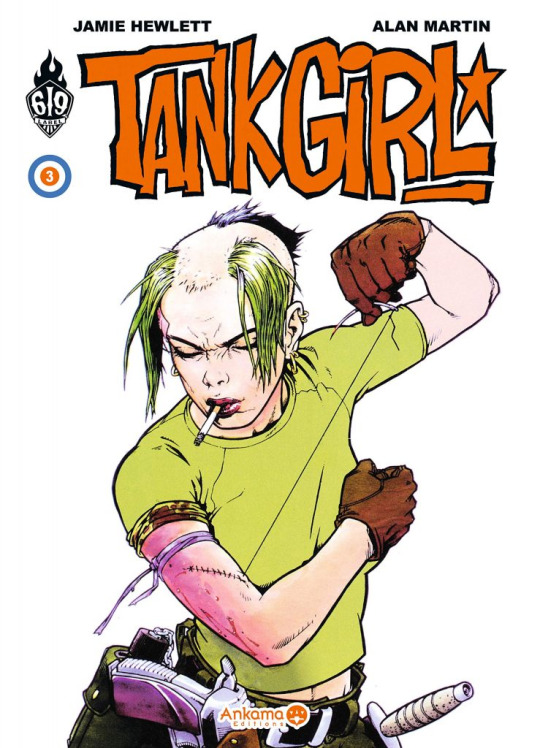
In my mind, Hay Lin had already existed for a long time: I had been drawing her since high school, but she was a punk with military boots," Alessandro revealed to me.
Elisabetta Gnone told me that the concept was considered too "masculine," so she proposed the idea of the five witches, which directly connected us to manga.
Some people at Disney Italy were afraid that, given the theme, it would veer into Satanism, but their greatest fear was the manga-style big eyes!
Canepa: For them, it was inconceivable to publish a comic even vaguely inspired by manga, which at that time were their direct competitors in the market.
Barbucci: At one point, they considered investing in the relaunch of Daisy Duck by introducing our five characters as anthropomorphic animals. It was an attempt to somehow connect with the Disney universe.
Canepa: Yes, exactly. The project was called Daisy D. and it was intended for the monthly magazine Minnie Mag. The story featured Daisy Duck as a private investigator, accompanied by our W.I.T.C.H. characters, who in this version would have had snouts and gloves, just like Minnie and Mickey!
I still have the first page done in watercolors, as we wanted to make it like the pages of Paperinik's Trip...
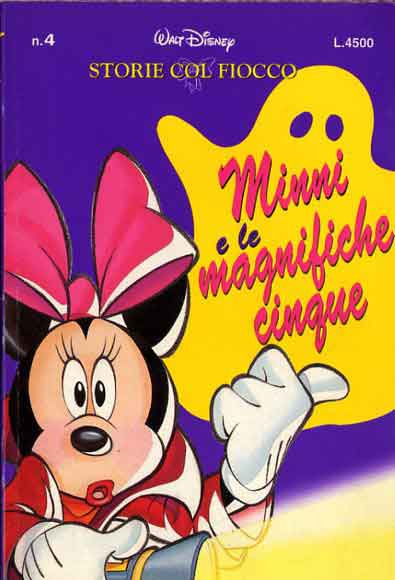
The scriptwriter, Ilaria Isaia, revealed to me that the inspiration for Daisy D. came from the success of "Minnie and the Magnificent Five," a story published in Minnie & Company in 1993. It featured Minnie in the role of an investigator, solving a mystery connected to five girls. Daisy D. wouldn't have been very different: "It revolved around Daisy Duck as an investigator, called by her friend to investigate mysterious events happening in a college attended by five students with magical powers," explains Ilaria.
Barbucci: Fortunately, nothing came of it.
Canepa: We were well aware that a story starring Daisy Duck wouldn't resonate with teenagers. We needed five normal girls that the readers could identify with...
Barbucci: So, the W.I.T.C.H. characters returned to being human.

For Will's design, Alessandro Barbucci Alessandro Barbucci was also inspired by "Alita" (1990) by Yukito Kishiro.
The graphic style of W.I.T.C.H., while drawing inspiration from manga, remains a hybrid of the West and the East. It doesn't stray too far from certain Disney characters, starting with Ariel from "The Little Mermaid" (1989).
Barbucci: I can tell a funny anecdote about this!
As we mentioned, Disney Italy opposed W.I.T.C.H. in every way possible: they particularly disliked those manga-style big eyes.
Together with Elisabetta Gnone, we came up with a game, a kind of bet with the top executives of Disney Italy. I drew a series of eyes, including manga characters, Disney characters, and our W.I.T.C.H. characters. Only the eyes were visible, nothing else.
"Since you have so much to say about these manga eyes, guess which ones belong to the W.I.T.C.H. characters!" That was the bet: they could no longer complain.
Well, they were wrong: they chose the eyes of Ariel from "The Little Mermaid" (1989), the protagonist of the Italian magazine of the same name, directed by Elisabetta herself, and successfully published by them for years.
They didn't take it well...

Indeed, Ariel broke the Disney graphic conventions with the proportions of her face.
Barbucci: It was a "graphic shock," something that had never been seen in Disney until that moment. It was certainly a step towards manga aesthetics, with these very large eyes that we later found in the design of many subsequent characters, from Belle and Jasmine to Anna and Elsa.
We remember that you and Barbara worked on the magazine "The Little Mermaid" in the 1990s, just before W.I.T.C.H. started.
In the covers drawn and colored by Barbara, I can already perceive some hints of manga style. Was it intentional?
Canepa: Absolutely yes!
At that time, I bought Japanese magazines like Newtype and Animage to get inspiration. In one of the illustrations I made, there's Ariel with a straw hat: I think I took inspiration from an image of Nadia from "The Secret of Blue Water" (1990-91), or maybe from some other cover.
The close-up of the face, as well as the fluttering leaves [like flowers in shoujo manga, editor's note], the pose of a model on the cover of a fashion magazine... it was all too innovative and "manga" for Disney Italy at that time, which often had something to say about my work! Even before W.I.T.C.H...

The scan on the left is taken from the website www.onlyshojo.com.
Walt Disney Company Italy didn't want anything to do with W.I.T.C.H., as we mentioned. What made them change their minds?
Barbucci: We worked on it secretly for at least a year, even at night.
Then, finally, a ray of light...
At the time, the main headquarters of Disney would send representatives around to other offices to find out what was being done in the rest of the world. Elisabetta was lucky to come across an American manager who was a big fan of Wicca. [Secretly from the top management, editor's note], she presented W.I.T.C.H. to him: he fell in love with it and financed the project, ordering Walt Disney Company Italy to proceed with its production.
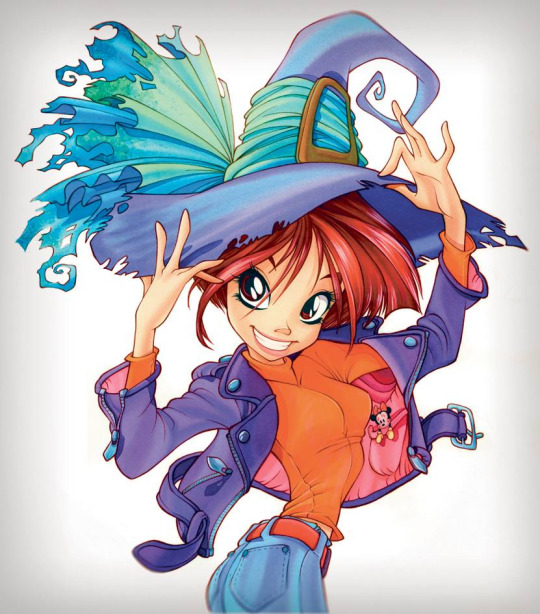

Concept art created by Barbucci and Canepa between 1998 and 1999. Notice the homage to Minnie in the first illustration!


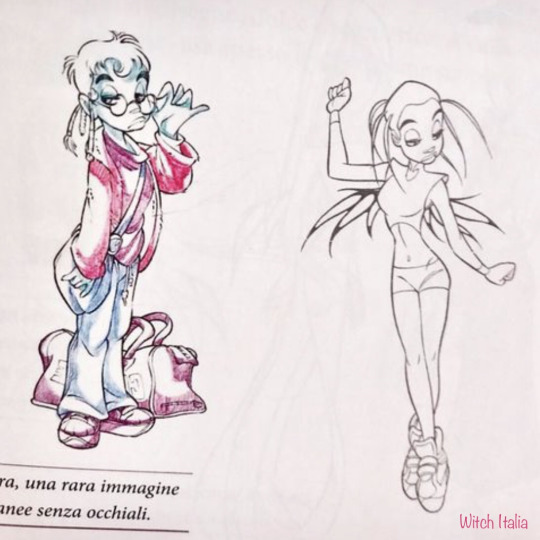

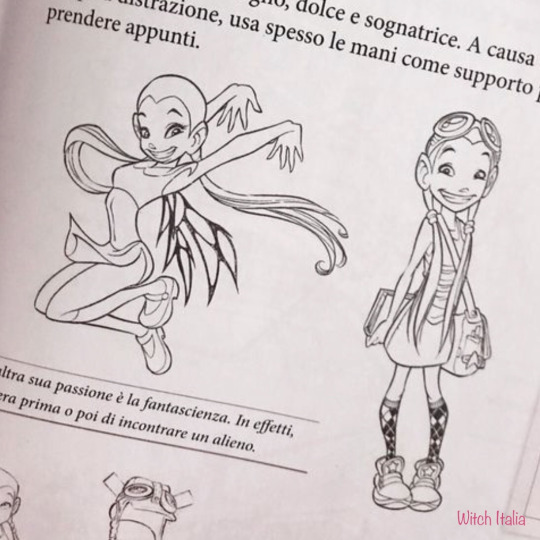
Images provided by W.I.T.C.H. Italia.
The project then gets underway. How did you divide the work?
Canepa: It's hard to say. Officially, Elisabetta wrote the plot, Alessandro created the character design, and I took care of the color and atmosphere. In reality, the three of us worked together on the concept, characters, and the world they would inhabit. We drew inspiration from our personal lives when creating these five girls.
The city of the W.I.T.C.H., Heatherfield, is a mix between our hometown of Genoa and San Francisco, which we had visited together. Will shares my birthdate, while Elyon shares Alessandro's. At the time, I was a big fan of frogs, just like Will!
Cornelia's cat is named Napoleon, just like mine - I also gave the same name to Elisabeth's cat, the protagonist of the first volume of END, the comic I created with Anna Merli. For Hay Lin's restaurant, we were inspired by a small Chinese "hole in the wall" where we often ate near our apartment in Milan...
In short, W.I.T.C.H. was built and conceived based on our personal experiences: friends, memories from adolescence, and more.
Based on these characterizations, I created the character profiles that you can find in the first five issues of the magazine, as well as some internal editorials.
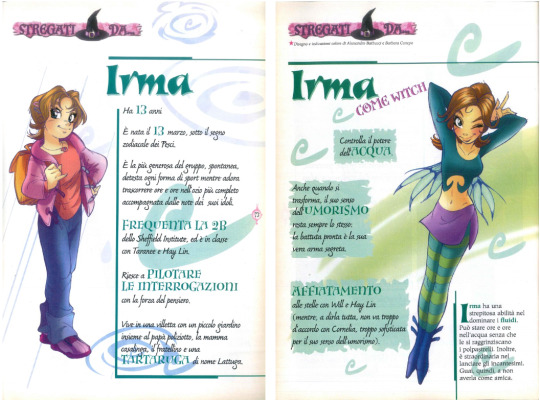
The character of Irma is inspired by Barbara Canepa in terms of design and personality, while Will is inspired by Elisabetta Gnone: with her, she shares an introverted personality and the detail of touching his hair when she is embarrassed.
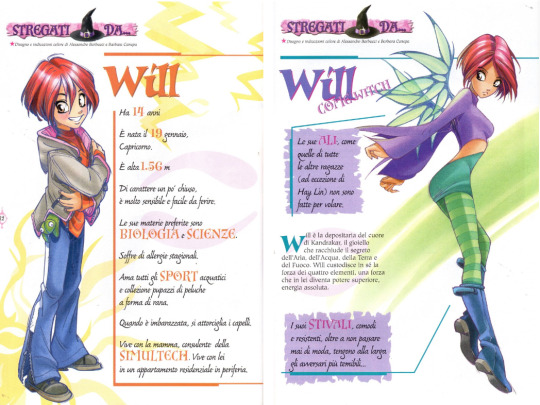
Scans by poochieandotherfriends.it
Elisabetta chose the ethnicities and names of the girls, coming up with the acronym W.I.T.C.H., while Alessandro created the symbols of the Guardians.
To draw the Heart of Kandrakar, Alessandro was inspired by a pendant, a unique piece that I was very attached to and still possess to this day!
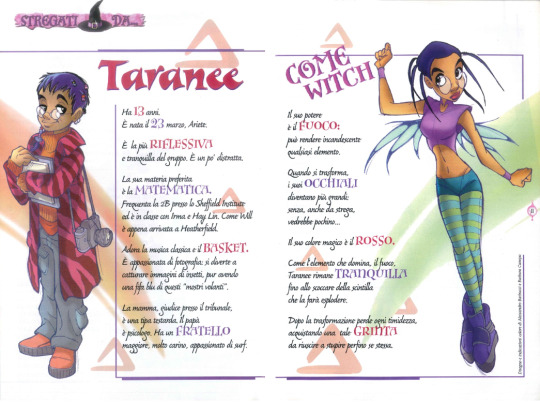
Scans by poochieandotherfriends.it
Lastly, I'll reveal something you may not know: I was the one who designed the Witch's transformed costumes!
I remember when Elisabetta jokingly scolded Alessandro, telling him to draw them less provocatively... (laughs).
As for their everyday costumes, Alessandro created them, often drawing inspiration from his and our friends.

Scans by poochieandotherfriends.it
Another significant responsibility of ours was to form a team of artists who would work on W.I.T.C.H. alongside us.
In fact, Alessandro and I couldn't have done it all by ourselves: W.I.T.C.H. was becoming a massive and important project, especially since it would be released on a monthly basis!
Therefore, we conducted courses at the Disney Academy: Alessandro taught how to draw the Witch, while I taught manga techniques, coloring, and graphic design.

Scans by poochieandotherfriends.it
Did you encounter any other issues with Disney Italy during the production?
Canepa: There were some controversies, but at that point, the project was already underway.
There were several delays, actually: the first issue was supposed to be released on Halloween in 2000.
I remember that they criticized the covers: they didn't like the white background, and in the first cover, they didn't like the difference in proportions between Will and the others, which is another typical graphic characteristic of manga.
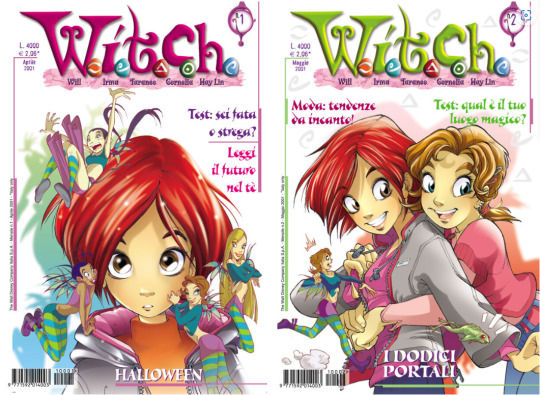
Barbucci and Canepa created the first five covers of W.I.T.C.H. and the corresponding chapter opening pin-ups.
You create the comic of the first issue: On the third page, there's a very intense panel with Will partially nude (without nipples); she appears like that later during the Sailor Moon-style transformation as well.
These are not erotic images, but they certainly deviate from the Disney style.
Did you face any issues regarding this?
Barbucci: Strangely, no. Maybe they had already given up at that point...

Scans by poochieandotherfriends.it
You left the project after the sixth issue. What happened?
Barbucci: The back and forth with Disney to bring W.I.T.C.H. to newsstands was incredibly exhausting. By the year 2000, we were drained from the continuous meetings, discussions, and delays...
Moreover, both Elisabetta and we had realized our potential as authors. She was the first to leave: she left the world of magazines to fulfill her dream of becoming a novelist. And she succeeded greatly, as a few years later, she created the Fairy Oak series of novels, which sold millions of copies worldwide!
Barbara and I were already in contact with various French and American publishers.
In France, they allowed us to express ourselves artistically in a completely free way.
It felt like a dream! There were so many things we wanted to talk about, things that weren't even proposable in Disney: sex, religion, politics... Sky Doll was born during this period.
Furthermore, there were legal disagreements with Disney regarding the moral rights of the Witch characters. In short, after a few years with the multinational company, it was time for us to move on to other things.
We needed a change of scenery!

The story you had in mind for W.I.T.C.H. was different from what we later read in the issues after your departure?
Canepa: Yes, it was darker, introspective, and more complex. It was a glimpse into teenage life presented through five very different girls.
The plot had different layers of interpretation, including ecological aspects.
It was certainly closer to manga in terms of themes: there was more focus on the girls' personal lives, their adolescent struggles. There wasn't a clear division between good and evil: the girls would be drawn to the Metaworld and tempted to join, crossing over to the other side of the barricade. Elyon would be the first to succumb, but they would all do so to some extent, even fighting against themselves.
Moreover, the Metaworld was a fascinating place, a natural paradise that was quite different from the medieval setting that Disney eventually created. At the heart of it all was the concept of growth and transformation, which is so dear to adolescence: the girls would have had the ability to transform into fantastic animals!
Like teenagers who find themselves caught between childhood and adulthood, the W.i.t.c.h. would have been caught between two worlds, remaining trapped in one or the other, by choice or against their will. It wasn't always clear...

The W.I.T.C.H. transform into adult versions of themselves, adhering to the main theme of many majokko ("magical girl") anime.
Even Elyon, who in the version you have read is the princess of Meridian, was a very different character in our story. She was the Guardian of the Metaworld and had powers related to time, wild nature, and death.
She would have tried to bring the other girls to the dark side and then redeem herself: in the last issue, she would have sacrificed herself to save the lives of her friends.
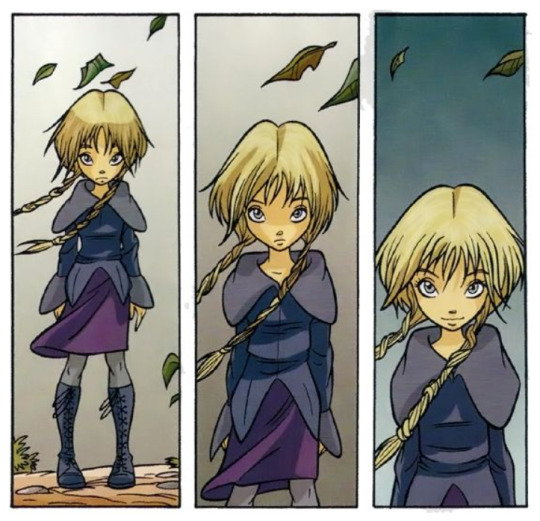
In W.I.T.C.H. #2, you can perceive some traces of the original Elyon, who at a certain point addresses the girls repeating, "Come to me, come to me..." as if trying to lead them to the dark side.
I transferred her main power, the ability to "bestow" death, to the protagonist of END, Elizabeth: with this character, I have done and will do everything that I couldn't do with Elyon, who was initially supposed to have white hair like her.
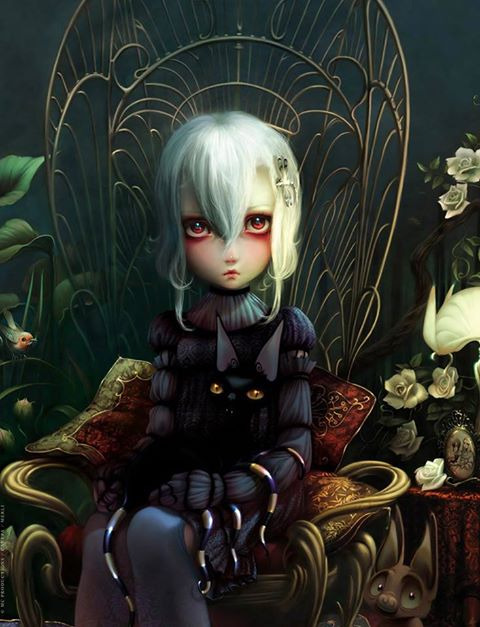
Barbucci: What was actually realized was a harmless mythology, closer to fairy tales and therefore to the Disney style. There is no mention of witches anymore...
We would have focused on a more New Age aesthetic, with references to Wicca, which was very popular in those years.
After leaving W.I.T.C.H., you left Italy for France, from where you embarked on various successful projects, with Sky Doll first.
It can be said that you found your dimension and creative freedom.
Now that 20 years have passed, what is your relationship with W.I.T.C.H.?
Canepa: It's needless to say that the bond has always been very strong and still is today. It was our own creation for a long time: seeing it succeed worldwide brought joy, but also suffering because we felt disconnected from it.
Barbucci: It was a love-hate relationship, but I must say that it gave me the greatest satisfaction of my life: seeing dolls of the characters I drew being sold in supermarkets!

Some sketches made by Alessandro Barbucci at the beginning of 2021, to celebrate the twentieth anniversary of W.I.T.C.H.
Canepa: After twenty years, perhaps it can be said that we have made "peace" with what happened. The hardships we endured have now drifted away with the wind, and that's how it should be.
Today, I can talk about W.I.T.C.H. with more tranquility, almost with tenderness. For many years, I didn't even want to face it. Initially, leaving Italy helped, but then W.I.T.C.H. reached France and the rest of the world. Over time, this forced me to look at it with more "serene" eyes, so to speak. If I hadn't left W.I.T.C.H., I would never have created Sky Doll and END, and perhaps I would have never become the director of a French series that, today, celebrates nearly 100 books 12 years after its creation.
Destiny, then? I believe so. Fate wanted to take something away from me to give me something else. In hindsight, I truly believe there was a magical thread in all of this... or rather, a true witch's touch!
There is a happy ending to it all: today, history reminds us that we are the true creators of W.I.T.C.H.
The readers know it, and so do industry professionals. Even Disney, in the end, acknowledged us.
Every now and then, Elisabetta, Alessandro, and I talk and, laughing, we say, "What if we got back together and remade W.I.T.C.H. in our own way?"
In any case, this remains and will always be the most important project of my life.
And to have touched so many hearts around the world... well, there's nothing more beautiful and satisfying.
So, thank you all.
I was happy to give you these five girls.
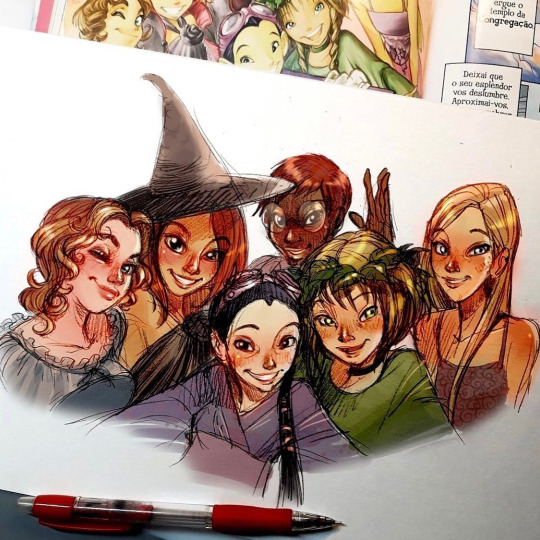
For Women's Day 2021, Barbucci drew again the famous pinup from the first issue, Halloween.
Current and Future Projects
Alessandro Barbucci
His most recent work is "Le Sorelle Grémillet" where he returns to portraying teenage girls ("it's a bit like how I would have liked to create W.I.T.C.H. back then, but it wasn't possible").
Additionally, Alessandro continues to work on "EKHÖ" and other projects.
Follow his Instagram and Facebook to stay updated!
Barbara Canepa
For over 12 years, Barbara Canepa has been the editorial director of the Metamorphose series for the French publisher Group Delcourt, with over 100 published books.
She has several projects in the works, including "MINA's Diary," where she will serve as the writer, while Isabella Mazzanti will handle the artwork and coloring. The work is a free interpretation of Stoker's Dracula, introducing a new way of conceiving vampires.
For the past two years, she has been finishing the writing of 12 volumes of a new jeunesse series, "GREENWOOD," aimed at rediscovering and respecting nature to the fullest.
Stay updated on her activities by following her on Instagram and Facebook!
#w.i.t.c.h.#interview#alessandro barbucci#barbara canepa#disney#witch#elyon escanor#will vandom#irma lair#taranee cook#cornelia hale#hay lin#end
61 notes
·
View notes
Text
Planning vs Reacting: A Yuri-Yaoi Take On Two Superhero Relationships
By blank
[a/n: putting this essay on here too for convenience and for @aelyris who wanted to see it, you're a gem. also partially going under a cut because i did write like 1.2k on this]
Though many people are aware of western superhero comics- Spiderman, Batman, Superman, to name a few- generally it’s the characters alone who are known. Their relationships to one another are understood through reading the source material, despite them changing from many different interpretations across the decades and writers that have taken it upon themselves to put their own flavor on the text. Of these relationships, this essay shall focus on two specific ones, both of which share the same character of Bruce Wayne (also known as Batman). The oldest relationship has been known for decades since their first meeting in 1939, as it is with another juggernaut of the genre, Superman. The youngest, however, has only been around since 2020, with Ghostmaker’s appearance in Batman #100. This essay looks to expand on these relationships through the lense of yuri and yaoi.
According to what tama (2023) writes in Yaoi is for people who bit their peers in childhood, Yaoi Magazine, Volume 2, our average view of what makes something yuri has been misconstrued and made anew into something more palatable to the general public through online jokes. "And this too is yuri" is a common phrase, repeated many times throughout several online spaces, and most often referring to a simple definition of yuri in which any relationship, as long as it didn't involve two women, could be yuri.
In their essay, tama states that this concept is held primarily by non-yuri fans, because this belief invalidates the basic idea of yuri; that is, passion. Yuri is characterized by intense emotion, thought out, scrutinized and sometimes, though not always, acted upon, between two women. Yuri is, however, not limited to women; yuri is an overwhelming presence of what could be called obsession in a relationship. This is a contrast to yaoi, which is not defined by a lack of passion, but by a lack of thought. Yaoi contrasts so sharply with yuri, the yang to its ying, because it most often presents itself through action. Rushing to, as tama elegantly states, "gripping a cute boy by the back of his neck and shaking him until he whimpers", and not thinking of the consequences of the action.
In the context of superbat (the relationship name for Superman and Batman) and ghostbat (relationship name for Ghostmaker and Batman), it’s clear to see where these characteristics shine through the most. Superman is a smart man, sure, but what matters most is that he is first and foremost kind. Superman is a man of action and reaction, the man who swoops in front of a train to avoid letting it hit a child, not thinking of alternate paths. He’s the light to Batman’s darkness, the action to his planning, the charming country boy to the local orphan billionaire. There are few writers out in the world who have avoided the alluring call of opposite and complementary aesthetics, and superbat as a whole are not among those few examples.

From Action Comics #1000 (Early June 2018) with art by Jim Lee (pencils), Scott Williams (inks), and Hi-Fi Design (colors)
On the other hand, Ghostmaker is a master planner on par with Batman; his rival, his parallel. Many aspects of his life as a vigilante are a direct callback to Batman’s, including The Haunt, a.k.a Batcave 2.0, in which he even stores a Spinosaurus to compare to Batman’s T-Rex (and his is bigger). Every aspect of him is in one way or another intertwined with Batman’s. As is revealed in Batman #100 and elaborated upon in the Batman: The Knight, Ghostmaker and Batman have known each other since they were teenagers, and spent much time learning side-by-side from the greatest masters known from several disciplines. Despite their select differences- namely Ghostmaker’s lack of a moral code and many emotions, in contrast with Batman’s famed rules and his endless emotionality, be that grief, rage, or love- the two are evenly matched and consider each other their equal and rival.
Batman is, himself, an almost immutable center of yuri. He is passion, grief, love, and a thirst for justice that is only fueled more and more by those same emotions. His crusade is born out of an avoidable tragedy that he refuses to let others suffer through, if he can, and his way of accomplishing that relies primarily on his skill and intellect. Batman is known for his million contingencies. He plans ahead, for everything that he possibly can, and that razor-sharp focus lives at the core of who he is, as well as making him a great example of everything yuri is.
An understanding of yaoi is essential to superbat, as is an understanding of yuri to ghostbat. There is little space for rationality in superbat’s actions together, despite Batman’s attempts to direct them; Superman’s emotions and recklessness are rewarded in kind with Batman showing himself in a more vulnerable way towards him, allowing them to circle closer to one another and stand together in the same ground. Despite the many differences between them, their shared emotion, the need to reach out and touch, connecting themselves to one another, is what defines their relationship and marks them as unequivocally yaoi.
Contrastingly, ghostbat is a relationship that balances on a razor wire edge between passion and logic. They’re similar and knowledgeable about each other enough to calculate almost every action and reaction that the other would take, but that almost is what gives them enough space to challenge one another. They’re both planners, people who constantly contemplate what the next step should be. Despite that, many of their interactions are bursting with passion, with their need to have each other’s acknowledgement, the desire to touch but the refusal to do so unless it’s all carefully thought out beforehand. They are obsessed with one another in a way that yuri portrays perfectly.
The use of a primarily eastern concept such as the dichotomy of yuri and yaoi may seem odd in explaining two non-canonical gay relationships in a western comic, but it is ever more prevalent in our present times. Yaoi and yuri are everywhere, after all- even when there is nothing. Perhaps especially where there is nothing. This essay hopes to help explain why this concept is helpful towards the analysis of any relationship, but especially in this, where we are present with drastically different foils that both oppose the same character in different ways. And despite their differences, both pairs reach a state of equilibrium just the same.
Sources:
tama, (2023) Yaoi is for people who bit their peers in childhood, Yaoi Magazine, Vol.2 (tshirt et. al).
Comic Volumes Batman: The Knight (1-10), Batman #100, Batman #109, Superman Action Comics #1000.
A special thanks to the people I spent about twenty minutes explaining yaoi-yuri to, the discord server that got a no context snippet and helped me figure out What Am I Even Saying, and the people I was definitely supposed to be paying attention to today instead of spending that time writing this. I have no regrets.
#lo's stuff#this is both the funniest thing i've written and not funny at all#i HAVE to write more yaoi essays tshirt et al you're all my heroes#anyway#ghostbat#minhkhoa khan#superbat#superman#batman#yaoi academics#i'm making that one a tag i need it for organization purposes#i see too many good yaoi academia not to want to find them again#ghostmaker#dc#yeah i'm maintagging it. look at my yaoi-yuri academic boy
17 notes
·
View notes
Text
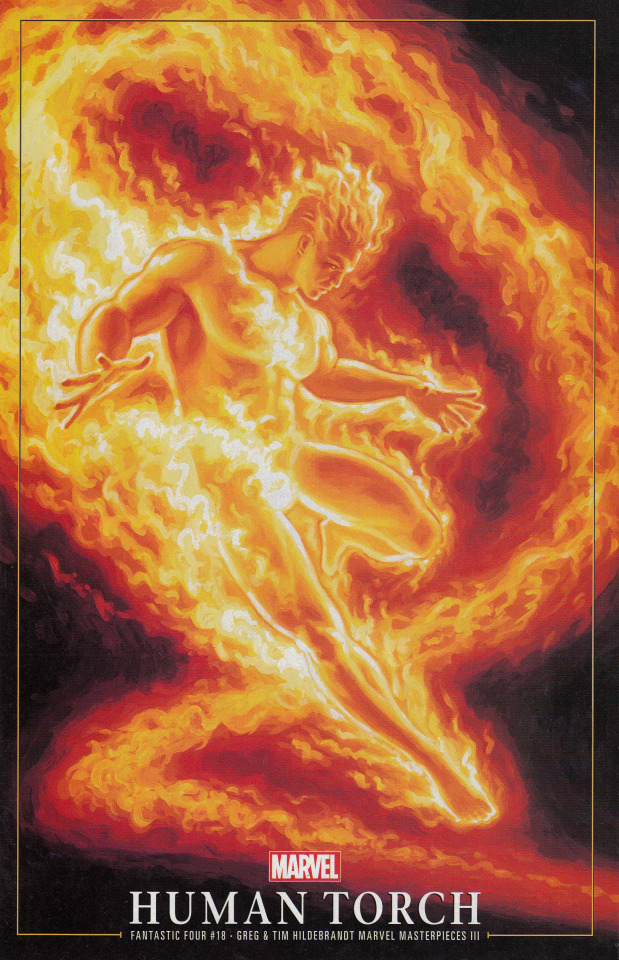
Fantastic Four #18 (Variant Cover)
#fantastic four#the human torch#johnny storm#fiery#marvel masterpieces#variant cover#tim hildebrandt#greg hildebrandt#marvel comics#comics#2020s comics#the world’s greatest comic magazine
28 notes
·
View notes
Text
Little hidden gems from big russian authors
In the 19th century, Russian culture reached its peak. In this "Russian Golden Age", arts, culture and especially literature became known worldwide. This is a list of small masterpieces written by the great Russian authors of this period.
1. Alexander Pushkin // "Little tragedies" (collection of short plays // 1830)
Pushkin is known as the first great poet of Russia. His realistic writing is combined with romantic, elegant elements. What not many people know is that he also wrote plays. "Little Tragedies" is a fascinating collection of 4 unique plays, later adapted for opera.


2. Mikhail Lermontov // "Masquerade" (theatre play // 1835)
Considered the greatest poet after Pushkin, Lermontov contributed to the enrichment of the Russian language and culture. A great romantic poet, he is also an important playwright. "Masquerade" is a play written in the specific, critical style of Lermontov, in which the idea of freedom and independence is debated.


3. Nikolai Gogol // "Petersburg Tales" (collection of short stories // 1843)
Known for his famous comedies such as "The Government Inspector" and "The Gamblers" and for the novel "Dead Souls", Gogol was an influential Russian writer. The small collection of stories "Petersburg Tales" includes a fascinating series of short stories from different genres.


4. Ivan Turgenev // "A nest of the gentry" ( short novel // 1859)
Turgenev is the Russian writer closest to the Western European literary tradition. Very critical of his fellow Russians, his novels and stories emphasize the decadence of the golden years, the war between generations and the misery of the contemporary spirit. "A nest of gentry" is a small novel easy to read, with a fascinating storyline and complex characters.
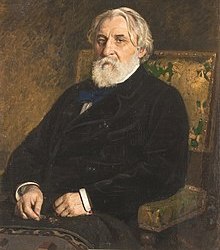

5. Fyodor Dostoyevsky // "Notes from the underground" (short novel // 1864)
I think there is no person who has not heard of Dostoevsky. One of the greatest writers of all time, his great novels have been translated into dozens of languages. Known as the faithful Orthodox writer, he develops the idea of the misery of the soul and human suffering. Many consider him the father of existentialism. "Notes from Underground" is a small novel that explores its big themes and is a fascinating read.

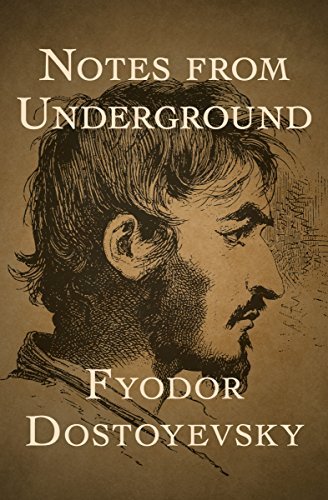
6. Lev Tolstoy // "The Death of Ivan Ilyich" (novella // 1886)
Tolstoy easily finds his place next to Dostoevsky. With a precious and analytical style, Tolstoy traverses the Russian bourgeois and aristocratic world and goes deep into both the mind and the soul of his characters. The novella "The Death of Ivan Ilyich" reflects on the serious theme of death in a tormented and poetic way at the same time.

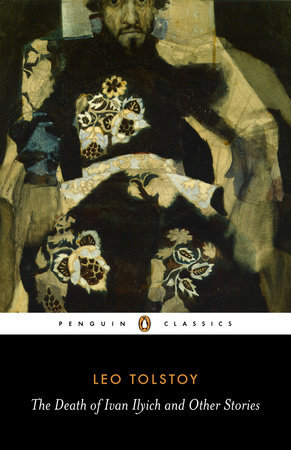
7. Anton Chekhov // "Ward no.6" (novella // 1892)
The last of the great writers of the golden age, Chekhov is known as a great dramatist with an extremely refined and sometimes even dark sense of humor. He wrote most of his life comic stories that he published in satirical magazines. His least known works are the short stories, created in a much more philosophical and meditative style. "Ward no.6" is one of the most special of them, in which the doctor of a small town finds an escape from the monotony of his life in discussions with a patient from the mental ward.
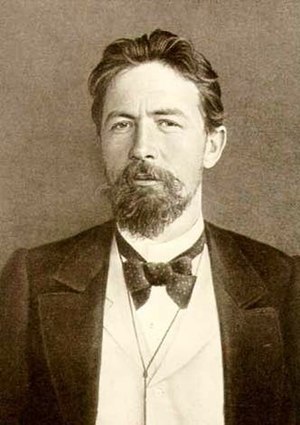
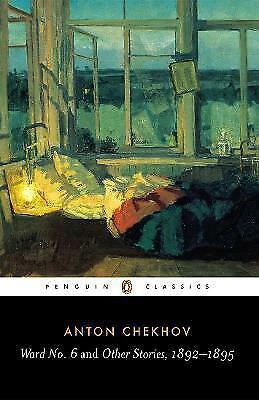
#russian literature#russian language#russian writers#19th literature#19 century#literature#classic literature#classic authors#alexander pushkin#mikhail lermontov#nikolai gogol#ivan turgenev#fiodor dostoievski#fyodor dostoevsky#leo tolstoy#anton chekov#darkest academics#darkest academia#dark academia aesthetic#dark academia#classic academia#academia#academics#classical academia#academia aesthetic#chaotic academia#light academia#bookblr#reading#bucketlist
66 notes
·
View notes
Note
Sorry, I see you already answered that question in 2021, found that post.
My new question is: what is “the shadow”?


(Art by Dan Schkade)
“Who knows what evil lurks in the hearts of men? The Shadow Knows…” The maxim that the weed of crime bears bitter fruit, intoned at the start of every program, was biblical in its sternness. The Shadow was an Old Testament avenger, a ruthless slayer of the wicked, very befitting the Depression decade of his greatest strength. The Shadow was both the force for good and lurker in the darkness. - The Shadow Scrapbook
The Shadow, also known as The Master of Darkness, The Dark Avenger, The Master of Men's Minds, Weird Creature of the Night, Identity Theft Georg, That Guy Who Lives in Lamont Cranston's House, "Shads" and other many names, is a mysterious figure who fights evil by turning it against itself. He is a former globetrotting aviator-spy-soldier (revealed to be named Kent Allard, 7 years into the character's run) turned crimefighting paladin who fights to protect and uplift the innocent and bring justice to victims of strife and calamity, and he does so with the black-clad design, domineering charisma, sinister cackle, Machievellian theatrics and ruthless efficiency of a villain.
In action, The Shadow loomed as a cloaked figure, materializing from out of the night, rescuing helpless victims and striking terror into the hearts of evildoers. However, he reserved such theatrics for a logical climax. Between times, The Shadow proved himself a master of deduction as well as disguise.
While his major missions were to stamp out mobs or smash spy rings, he often tabled such routines in order to find a missing heir, uncover buried treasure, banish a ghost from a haunted house or oust a dictator from a mythical republic. The Shadow was such an incredible character in his own right that almost anything he encountered was accepted by his ardent followers. - Walter Gibson
The Shadow began life as the spooky narrator of publisher Street & Smith's radio program, whose sibilant, mocking personality and sinister cackle were dramatically more interesting than any of the programs he was narrating, and so when listeners started asking Street & Smith for a Shadow Magazine that did not exist, they had to make one of their own. To that end, they recruited a young magician turned newspaper writer and former associate of Houdini's fraud-busting network, Walter Gibson, to write the adventures. Gibson was extremely acquainted with the ins and outs of illusionism and sleight-of-hand and worked personally with many of the greatest magicians at the time, and would extensively use said knowledge in crafting The Shadow's character and adventures.
And so The Shadow Magazine began, reviving the "hero pulp" format that had died out in the pre-WW1 dime novels and redefining the mold of crimefighting "pulp heroes" from that decade onwards, as well as many superheroes from that time period inspired by him and his successors. He is currently more famous for being plagiarized by the chief inspiration for a certain guy who runs around with bat ears and for his general role as a highly influential forerunner and influence in forms of storytelling still extensively used today.
On the taxonomical chart of Western comics he’s a common ancestor for a sizeable chunk of the marketplace. Every street vigilante, every masked crime-fighter, every necessary monster: he’s in the DNA of them all. A living fossil, a coelacanth or goblin-shark for the comics world, swimming in waters of ice and ink - Si Spurrier
The Shadow maintained a fluctuating radio career over the 1930s to go along with his highly successful magazine, and he'd eventually reach newfounds heights of stardom from 1937 onwards thanks to the debut of a new radio show, initially starring Orson Welles in the titular role. Said radio show would become an audience hit well into the 1940s and would introduce new fixtures to the character such as friend-and-companion Margo Lane and an invisibility superpower, which were eventually integrated since into the comics and pulps and other media. You can still easily find many of the character's radio adventures online as well as his exploits in comics and pulps (harder to find now, but still possible if you know where to look). I'll pass along my personal recommendations here.

(Art from Matt Wagner's The Curse of Blackbeard Skull, in The Shadow #100)
In the taxonomical history of American crimefighters he sits in between the hardboiled detectives of the 1920s and the 1940s superheroes, and although the 1930s pulp heroes were in part defined largely by imitating him, he is no traditional square-jawed do-gooder: he is a tall, gaunt, cadaverous wraith with the mask of a Western bandit and a vampire's cloak and the clothes of 19th-century cartoons of saboteurs and anarchist bombers. The barest glimpse of the man beneath is that of a judgemental patrician's aquiline nose and intense, sharp eyes, like icepicks probing the back of your skull. He makes a point to show every now and then how easily he can reshape that face to suit his needs, and make it your own, even doing so in front of you to make a point.
He is Dracula meets King Arthur, Sherlockian brainpower and Lupin trickery joined forces, centerpiece to urban thrillers turned into fairytales as The Big Bad Wolf switches sides to save us. Though his setting looks the part, The Shadow is no gritty film noir creature: he is what happens when the cutthroat gangsters and invincible spymasters and predatory businessmen behind it all meet the actual scariest guy around: Death itself, as the ultimate master and servant joined in one, who found a higher calling fighting for us instead, breaking and bending and controlling the rules and tipping them ever so slightly in the favor of those who are usually in no position to fight back.
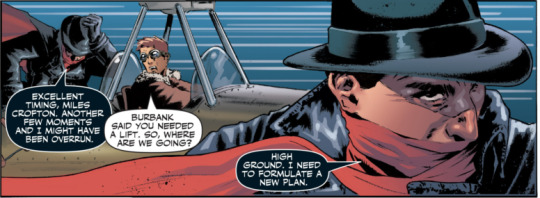
(Art by Giovanni Timpano, for The Shadow #25)
As we discussed The Shadow, I suggested an opening scene with a cloaked figure emerging from a night fog to prevent a desperate young man from taking a suicide plunge from a high bridge. Thus befriended, the young man would swear loyalty to his rescuer and thereby become involved in exciting adventures with otherp persons who had been aided by the same benefactor, all being united in a common cause against crime. - Walter Gibson
That is where the Agents come in. As The Shadow is a distant living puzzlebox, we are very rarely privy to his thoughts and feelings, he glides through many stories scarcely-seen until he needs to be, and so we frequently experience things from the viewpoint of proxies, whether they are agents or characters swept into intrigue that only The Shadow can save them from. The first Shadow story opens up with a broke and depressed young man named Harry Vincent, ruined by the Great Depression reality of the time and trying to commit suicide, who is saved from it by The Shadow, and upon accepting a new purpose in life as his agent, grows into a dependable and strong ally, friend and even leader to people once like him over the course of the following adventures.
Across his history The Shadow has had agents and allies among all walks of life: redeemed/pretend criminals who use their reputations to provide The Shadow with inside knowledge, war vets, police officers, prison reformists, troublemaking journalists, government agents, politicians, criminologists, psychologists, high society chameleons, streetwise cabbies, janitors, the homeless, even crooks who once worked for those that The Shadow opposed, with some stories dedicated entirely to The Shadow playing guardian angel or working to provide second chances to those who've turned to crime. Community leaders with opposing viewpoints, rebel spies, prostitutes, historical figures such as Amelia Earhart and Nikola Tesla, robots, political activists and freedom fighters, doctors, birds, boxers, actors, magicians, beavers, and a list too big to get into here. There was a crimefighting dog at some point also and he was a very good boy.
Said list also includes the guy most people initially assume is his secret identity, a wealthy globetrotting man-about-town named Lamont Cranston. The first on-screen meeting between The Shadow and his secret identity Lamont Cranston consisted of The Shadow showing up in the dark at Cranston's bedside, wearing his face and telling him in pristine detail how much he's usurped Cranston's life, and effectively blackmailing him into leaving town so he can continue being Cranston uninterrupted. It is considerably less known, however, that eventually Cranston and The Shadow became weird friends following this ordeal and worked together several times, with Cranston turning out to be a pretty entertaining hero in his own right even besides his designated purpose of being rich and useless, even he was not immune to The Shadow's ability to enact positive change on his allies. Which is one note I'll end this post on: that The Shadow and his surroundings can be a lot more layered than given credit for.
I make the argument again and again that The Shadow is an intriguing character with much more to him than simply the gun violence and spooky laughter and murderousness that he's frequently reduced to, even if he isn't quite consistently so (as expected of one who's been around in virtually every medium for over 90 years). He can be compassionate, thoughtful, cautious and consequence-minded in his approach to effectively combat crime and protect others, ridiculous, eccentric, flawed in ways big and small and humanizing, for better or worse depending on who's writing him. He is a versatile shapeshifter as well as an unassailable force of personality to throw into any gathering, any circumstance, any narrative, and remain unique.
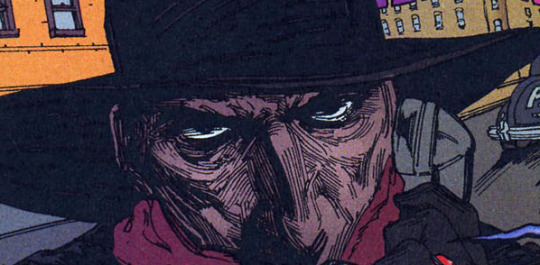
(Art by Michael Kaluta, from Hell's Heat Wave)
With those other “masked avenger” pulp types, their masked identities are an act, at least in part. Underneath the hat and mask they are regular guys with relatable motivations. With the Shadow, the guy in the hat and scarf IS the real guy, and his motivations and feelings are largely kept from us.
When we see him in his “civilian” identity, THAT is an act. So there’s a kind of brutal simplicity to his dialogue.
He is what he appears to be, and says exactly what he means. - Chris Roberson
And that's about it as a summary. I have a masterpost pinned at the top because, evidently, I have a lot more to say about the character and more I can't cover here. If you want, feel free to shoot me any additional questions and let me work out my fixation on the weird crime spooky murder man. I have to go off about him at least once a month or else I start eating my furniture so, help me out here.

#replies tag#the shadow#the shadow magazine#shadow comics#shadow radio#lamont cranston#kent allard#pulp fiction#pulp heroes
75 notes
·
View notes
Text


John Romita Sr. - Fantastic Four: World's Greatest Comic Magazine! #12 Splash Page 3 Doctor Doom Preliminary Artwork Original Art (Marvel, 2002)
Source
16 notes
·
View notes
Photo



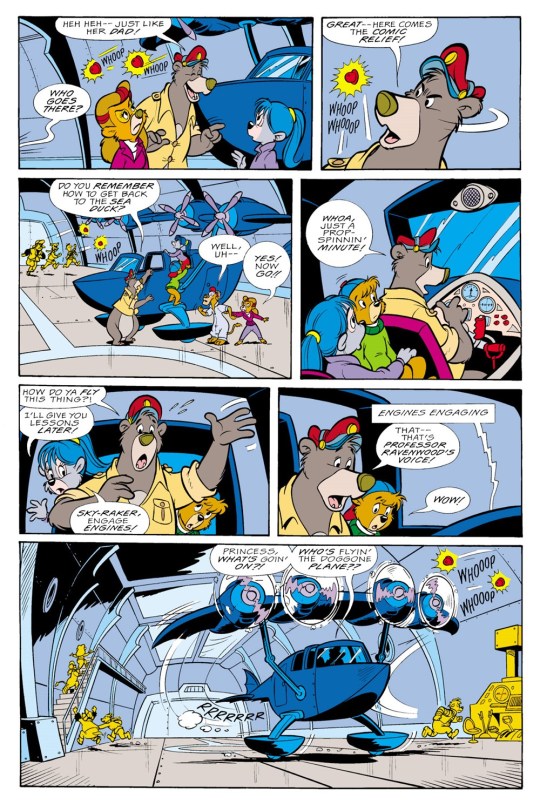



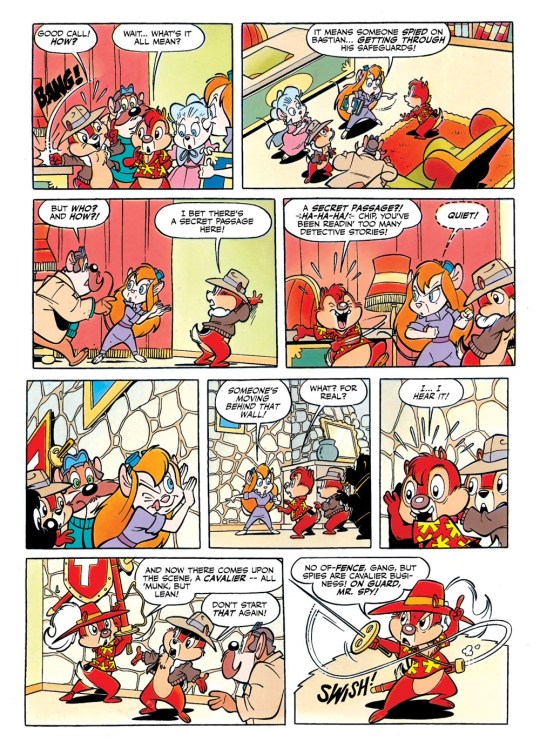
Disney Publishing Worldwide & Disney Deluxe Re-Publishing Disney Afternoon Adventures Comics For TaleSpin & Chip 'n Dale Rescue Rangers For 2023.
Seth Rogen’s TaleSpin is NOT real however this is an actual real thing, Disney Press & Disney Deluxe will re-publish Disney Afternoon Adventures Comics For TaleSpin & Chip 'n Dale Rescue Rangers for 2023
📚 TaleSpin- Flight of the Sky-Raker - February, 28, 2023
By Bobbi JG Weiss, Doug Gray, Lee Nordling
208 Pages
Disney Deluxe
Disney Press
Disney Publishing Worldwide
Can’t you feel the buzz? TaleSpin, Darkwing Duck, DuckTales, and Chip ‘n’ Dale Rescue Rangers are back — with more epic 1990s adventure comics spun off of The Disney Afternoon TV cartoons!
From Disney Adventures magazine and its sister comics magazines come more feature-length blockbuster tales! In “Flight of the Sky-Raker,” Baloo, Don Karnage, and Shere Khan wage a midair battle over the world’s first voice-controlled plane! In “Dime After Dime,” Magica de Spell’s clever niece Minima befriends trusting little Webby — should Scrooge McDuck be scared? Then in “For the Love of Cheese,” Chip ‘n’ Dale, Gadget Hackwrench, and the gang join forces with Jacques De Brie, international mouse of mystery! Plus Darkwing Duck, the Gummi Bears and more! “…Everybody’s busy, bringing you a Disney Afternoon!”
📚 Chip 'n Dale Rescue Rangers: The Count Roquefort Case - July 4,2023
By Bobbi JG Weiss, Doug Gray & Lee Nordling
208 Pages
Disney Deluxe
Disney Press
Disney Publishing Worldwide
It’s not a reboot… it’s a comeback! Chip ’n Dale Rescue Rangers, TaleSpin, Darkwing Duck, DuckTales, and Adventures of the Gummi Bears return—with more classic 1990s adventure comics based on beloved TV cartoons from The Disney Afternoon package!
From Disney Adventures and its Gen-X sister magazines come pulse-pounding sagas! In “The Count Roquefort Case,” the villainous Fat Cat wants to plunder the medieval legacy of Monterey Jack’s European forebears! Then “The Curse of Flabbergé” sends Scrooge McDuck and Launchpad McQuack to the cranky country of Brutopia, where heroic freedom fighters help in the hunt for a priceless treasure! And in “The Kitty Kat Kaper” and “Cat in a Hot Tin Suit,” Darkwing Duck fights his first-ever battles with the world’s greatest criminal mind… Fluffy! Plus TaleSpin, the Gummi Bears and more!
#TaleSpin#The Jungle Book#Jungle Book#Chip N Dale Rescue Rangers#Chip And Dale Rescue Rangers#Chip And Dale#Chip N Dale#Jymn Magon#Mark Zaslove#Tad Stones#Alan Zaslove#Bobbi JG Weiss#Doug Gray#Lee Nordling#The Disney Afternoon#Disney Afternoon#Disney Comics#Disney Afternoon Adventures#Disney Adventures
56 notes
·
View notes
Note
I'd really love the sci fi reading list, if it's not too difficult! Thank you for your explanation
Yes! Okay, requisite this is Not Authoritative Or Comprehensive claim, I'm a dork with a Russian degree, but here we go:
(I tried to organize this chronologically because if I did it thematically we would be here all day. Also, I still have more books, but they get increasingly niche. This is a Greatest Hits playlist, and if you look these people up, you will find their contemporaries)
(Long list below the Read More)
Jules Verne — 80,000 Leagues Under the Sea, Journey to the Center of the Earth. Excellent continuations of that exploration/'ostracized' genius figure, so popular in the previous century. French, so English translations. Kinda marks the transition point between 19th c. pure spec exploration and what we would call sci-fi. BUT BEFORE HIM...
Mary Shelley — Frankenstein is probably the first sci-fi novel as we know it. BUT BEFORE HER...
Margaret Cavendish — Okay, the 'first sci-fi novel' is hard to define for obvious reasons, but The Blazing World has as good a claim as any. Published in the 17th c., so it really traverses the genres, but includes a utopian kingdom accessible via the North Pole. Her husband was so impressed that he composed a sonnet for her, which serves as the epigraph for the novel; it's a wild read in the same way Robinson Crusoe and other early novels are, and I'm mostly including it here because it's so, so wild to read in 2023.
John W. Campbell — That dude. The hero's journey guy. His short story Who Goes There? Has been adapted a million times into a little movie called The Thing. Unfortunately got really into race science, so Isaac Asimov told him to fuck off. Edited the magazine Astounding Science Fiction, which in 1939 published Black Destroyer by Alfred Van Vogt, usually cited as the beginning of Golden Age sci-fi.
H. G. Wells — Big critic of class divisions in Victorian English society, coined the term 'time machine' as we think of it in his novel...The Time Machine. A lot of what we consider 'classic' time travel tropes were, if not invented here, had their seeds planted here. Also famous for War of the Worlds, leading to a MINOR disturbance when Orson Welles did a dramatic radio reading.
Edgar Rice Burroughs — the man, the myth, the legend. If I could persuade you to read one white English sci-fi author with rather dubious politics, it would be him, if only because of how influential he was. Mostly famous for Tarzan, but he also wrote a whole series about Hollow Earth that crosses over with Tarzan at some point (Pellucidar), as well as the series Barsoom (A Princess of Mars and its sequels), and Amtor (Guy named Carson Napier gets transported to Venus, which was a watery hellscape, as was popularly theorized for a while).
They're basically pulp comics before pulp comics, published in magazines, extremely lurid and dramatic, and he did write his own crossovers. These were what the first modern superhero comics writers often grew up reading and what inspired them—John Carter's cultural cachet was borrowed by Superman until it became his cultural cachet.
They're very fun, but also supremely products of their time, and extremely fond of the British Empire.
Judith Merrill — prolific writer and editor, who also wrote one of my personal favorite reactions to the atomic bomb in Shadow on the Hearth.
Gabriel García Márquez — we're gonna take half a sidestep into magical realism here (which is, to define quickly, a genre incorporating the fantastic into otherwise realistic narratives, often formed and associated with decolonial and post colonial Latin American fiction, but not always. It's a fuzzy genre). He wrote in Spanish, but I read him in English. One Hundred Years of Solitude is probably one of the great novels ever written. My mother is also telling me to rec Love in the Time of Cholera and she wrote about the man, so listen to her.
Jorge Amado — the sixties were the big magical realism heyday. Amado was Brazilian and his Dona Flor and her Two Husbands is a book my Spanish high school teacher made me swear to read some day.
Andre Alice Norton — Deserves a spot for being one of the most prolific sci-fi authors of all time during a time when sci-fi was INCREDIBLY inhospitable to women. Over 300 books!
Robert Heinlein — This man is the poster child for "male author who writes groundbreaking sci-fi novels but cannot be normal about women with a gun to his head". The Moon Is A Harsh Mistress is excellent and incredibly important for how comprehensive the creation of Luna and its workers was, even if it is very sixties free love. Also wrote Starship Troopers, the novel.
Edward Smith — you haven't seen drama until you read what they said when Lensman (first book is Triplanetary) lost to Foundation for the Hugo in the sixties.
Larry Niven — Fleet of Worlds! Ringworld won a whole host of awards and deservedly so in 1970. Fair warning, his stuff decidedly falls under "hard" sci-fi (lots and lots of discussion for plausible alien artifacts), though it is awesome just in terms of how he can communicate scale. If you see a big ring-like structure in space, you can thank this guy, basically (the term ringworld comes from here). Also did a bunch of co-writing. I haven't read his other stuff, but CoDominium is on my list (he co-wrote it. First book is The Mote in God's Eye). If you liked the TV show The Expanse when it did the alien stuff and the later books it never got to adapt, you'll love this guy.
Samuel R. Delaney — Dhalgren is a book I am forbidding you to research before reading. Go in prepared. You have been warned. You will either love this book or set it on fire.
Stanislaw Lem — Solaris. I started this novel last week after watching the Tarkovsky film and. It's doing something to my brain, that's for sure. It's a book where I have to read every sentence twice. If you read it, find a good translation if you don't speak Polish. The author famously is very mad at critics who use Freudian analysis for it, so tread carefully (it's about the limits of rationality and our ability to understand, so. Fair).
Joanna Russ — The Female Man is a seminal work of feminist sci-fi. It's—fascinating, to be honest. Discusses socially enforced dependence of women on men and the creation of a different gender, a "female man", when the protagonist chooses to reject it and thus her socially enforced gender. I wouldn't call it a transgender manifesto (written in 1975, features insufficiently masculine men undergoing sex change surgery, so...yeah) but it definitely awoke something in my brain when I was 16 lol. I would LOVE to see it revisited in literary criticism from a modern perspective, especially from trans people.
C.J. Cherryh — If we talked about female sci-fi authors from the 1950s-70s writing under gender ambiguous aliases, we would be here all day, so I'm picking the one whose books I got for cheap at a book sale. Her Foreigner series has such a good premise with descendants of a lost Earth ship and interstellar court drama, and it's SO fun.
Poul Anderson — the name is not a typo, do not look up Paul Anderson, you will never find him. I actually have a copy of Three Swords and Three Lions currently collecting dust on my shelf and judging me right now as I wait to read it. Tau Zero is one of the greatest things I've ever read. The time dilation stuff gets kinda dense at times, but he incorporates some interest in his Swedish history and folk tales into it, and his explanation of travel at the speed of light and incorporating that into his discussion of nationalism is incredible. The ending where they survived [REDACTED] and landed on what may have been [REDACTED] has been bouncing around my brain for a bit now.
Laura Esquivel — Like Water for Chocolate is from the magical realism reading list.
Salman Rushdie — Midnight's Children is one of those bucket list books, for better or worse. Recontextualized Indian independence from the British and the Partition through framing of a husband telling the story to his wife, as he actively tells the story to her. Really uses the fantastical versus the real w/history versus truth so well.
Nancy Farmer — The Ear, the Eye, and the Arm, for the kids lying about their age on Tumblr dot hell. Three kids try to escape a kidnapping after sneaking out—in 23rd century Zimbabwe. With the help of three mutant detectives. It rules.
Ben Okri — Okay, I have not read his stuff yet, but it is on my list. Other people here have discussed his influence on them in post colonial sci-fi. His big one is The Famished Road, first in a trilogy, and renowned for its discussion of the spiritual and realist world coexisting in African animist spiritual life.
Nnedi Okorafor — I have read one of her short stories, Remote Control, and currently have an book list with her other stuff on it. Other people I know vouched for her work. She specifically writes Africanfuturism and Africanjujuism centered around her Nigerian background, and follows on from the likes of Okri and Octavia Butler. I'd also add if you're a Stephen King fan when he's in Dark Tower mode, she's probably gonna have things that appeal to you.
Mentions that are absolutely influential but don't need explaining on this website: Franz Kafka, Ursula K Le Guin, Douglas Adams, N. K. Jemisin, Ray Bradbury, Arthur C Clarke, Isaac Asimov, Frank Herbert, Alduous Huxley, Philip K. Dick, Orson Scott Card, Kurt Vonnegut, George Orwell, Octavia Butler, Neil Gaiman, Toni Morrison.
(to be clear: you SHOULD read them, but you probably know who most of them are and/or why they're big deals. Most of them are also incredibly prolific, and explaining their bodies of work are other posts. Trying to make a list about other folks)
For more on Afrofuturism,(not to be confused with Africanfuturism), I recommend the shit out of Afrofuturism: The World of Black Sci-Fi and Fantasy Culture, full of short stories and guides to art and music. I, alas, lack similarly useful authoritative guides to other genres, but I have read that one, so wanna toss it out there. There's so much.
10 notes
·
View notes